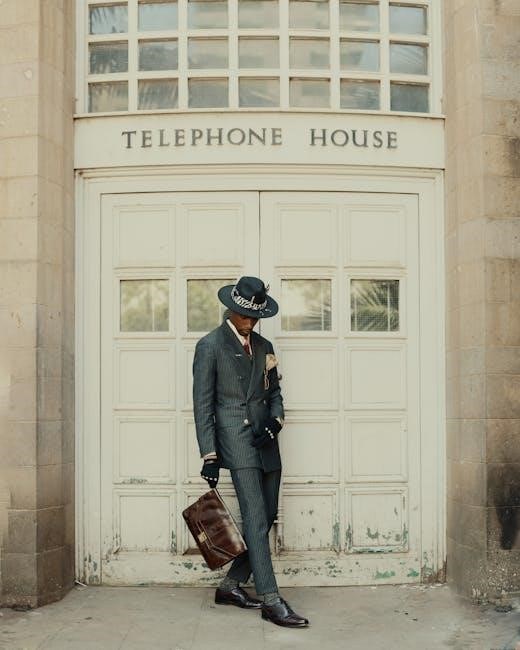Welcome to our Suit Coat Size Guide․ Discover how to determine your perfect fit and choose the ideal size for a tailored look․ Explore key measurements, tips, and style advice to ensure your suit fits flawlessly․
Understanding the Importance of Proper Fit
A well-fitted suit coat is essential for confidence, comfort, and style․ Proper fit ensures the garment drapes naturally, accentuating your physique while maintaining a polished appearance․ Ill-fitting coats can create an unbalanced look, making you appear boxy or overly tight․ Accurate measurements are key to achieving a tailored finish, ensuring comfort and professionalism․ A correct fit enhances posture, allows freedom of movement, and reflects attention to detail, making it a cornerstone of personal style․ Avoiding common mistakes like oversized or undersized coats ensures a sleek, modern aesthetic․ Prioritizing proper fit guarantees a timeless, sophisticated look tailored to your unique proportions․

Overview of Suit Coat Measurements
Suit coat measurements are crucial for ensuring a perfect fit․ Key areas include chest, shoulders, sleeve length, body length, and waist․ Chest measurement is the foundation, determining the overall size․ Shoulder measurements ensure a natural fit, while sleeve length balances proportions․ Body length affects coat style and comfort, and waist measurements tailor the fit for a slim or classic look․ Accurate measurements guide size selection, ensuring the coat drapes smoothly and complements your physique․ Understanding these elements helps you choose the right size, style, and fit, making your suit both comfortable and visually appealing․ Proper measurements are essential for a polished, professional appearance․

Key Measurements for Suit Coat Sizing
Chest, shoulders, sleeve length, body length, and waist are the primary measurements․ Accurate sizing ensures a tailored fit, balancing comfort and style perfectly․

Chest Measurement: The Foundation of Suit Sizing
The chest measurement is the most critical dimension for determining suit coat size․ To measure accurately, wrap a tape measure around the fullest part of your chest, keeping the tape level and parallel to the floor․ Ensure the tape is snug but not tight, with your arms relaxed at your sides․ This measurement directly corresponds to standard suit size charts, providing the base for your coat size․ For a tailored fit, allow a slight ease of 2-3 inches to accommodate movement and comfort․ Accurate chest measurement ensures a balanced, flattering silhouette, making it essential for a well-fitting suit coat․
Shoulder Measurement: Ensuring a Natural Fit

The shoulder measurement is vital for achieving a tailored, natural fit in a suit coat․ To measure, place the tape horizontally across the back, starting from the tip of one shoulder to the tip of the other, ensuring it follows the natural slope of your shoulders․ This measurement helps determine the jacket’s shoulder width, ensuring it sits comfortably without slipping off or digging in․ Proper shoulder fit is essential for maintaining the jacket’s structure and balance, complementing your posture and overall appearance․ Accuracy here ensures a polished, professional look that enhances the entire suit’s aesthetic․ Measure carefully to avoid a ill-fitting jacket․
Sleeve Length Measurement: Achieving the Perfect Balance
Sleeve length is a critical factor in achieving a balanced, polished look in a suit coat․ To measure accurately, start at the center back of the neck, running the tape over the shoulder and down to the wrist, keeping your arm relaxed by your side․ This ensures the cuffs will sit correctly, neither too short nor too long․ Proper sleeve length prevents the jacket from appearing boxy or overly tailored․ Avoid bending your elbow during measurement, as this can lead to inaccuracies․ A well-fitted sleeve enhances both comfort and style, making it essential for a refined, professional appearance․ Measure carefully for the perfect fit․
Body Length Measurement: Determining the Ideal Coat Length
Body length measurement is essential for ensuring your suit coat fits proportionally․ Measure from the base of the neck, down the spine, to the desired coat length․ Standard lengths range from 32 to 36 inches, depending on style․ For a classic fit, the coat should cover the hips, while a modern fit may be slightly shorter․ Ensure the length complements your height and body proportions․ A well-balanced coat length enhances posture and overall aesthetics․ Measure accurately to achieve a tailored look that aligns with your personal style and the occasion․ Proper length ensures comfort and a polished, professional appearance in any setting․
Waist Measurement: Tailoring for a Slim Fit
Waist measurement is crucial for achieving a slim, tailored fit in your suit coat․ Measure around the narrowest part of your torso, typically one inch above your belly button․ This ensures the coat isn’t too tight or loose, creating a streamlined silhouette․ For a slim fit, the waist is slightly nipped in compared to classic styles․ Tailors use this measurement to craft a coat that complements your body proportions․ Accurate waist measurement ensures the coat sits comfortably and maintains a polished appearance․ Proper fit at the waist enhances mobility and contributes to a modern, sophisticated look․

How to Measure Yourself Accurately
Measuring yourself accurately is essential for a perfect suit coat fit․ Use a flexible tape measure, stand straight, and ensure the tape isn’t too tight or loose․ Breathe naturally and consider enlisting help for hard-to-reach areas like the shoulders․ Measure chest at the fullest part under the arms, shoulders from one shoulder tip to the other, sleeve length from the base of the neck over the shoulder to the wrist, body length from the neck base to the desired coat length, and waist at the narrowest torso point․ Take multiple measurements for consistency and refer to size charts to match your style preference․
Tools Needed for Measurement
To measure yourself accurately for a suit coat, you’ll need a few essential tools․ A flexible tape measure is the most critical tool, ensuring precise measurements․ It should be made of vinyl or fabric for ease of use around your body․ A full-length mirror is helpful to see your posture and alignment․ Additionally, having a second person to assist with hard-to-reach measurements, like shoulder length, can improve accuracy․ Stand straight and natural during measurements, keeping the tape measure level and parallel to the floor․ Proper tools and technique ensure consistent and reliable results for a perfect suit coat fit․
Step-by-Step Guide to Measuring Your Chest
To measure your chest for a suit coat, wrap a flexible tape measure around the fullest part of your chest, just under your arms․ Stand straight with your arms at your sides, ensuring the tape measure is level and parallel to the floor․ The tape should feel snug but not tight or constricting․ Take note of the measurement in inches or centimeters, as this will serve as the primary sizing reference for your suit coat․ Accuracy is key, so avoid slouching or holding your breath․ This measurement is crucial for determining the perfect fit, ensuring comfort and a tailored appearance․
How to Measure Shoulder Length Correctly

To measure your shoulder length accurately, stand straight and relaxed․ Place the tape measure at the tip of one shoulder, just above the arm, and extend it to the tip of the other shoulder․ Ensure the tape measure remains parallel to the floor and lies flat against your skin․ This measurement helps determine the fit across the upper back and shoulders, ensuring the suit coat sits naturally without pulling or sagging․ For precision, avoid slouching or tensing your muscles․ The shoulder length measurement is crucial for achieving a balanced and comfortable fit in your suit coat․
Measuring Sleeve Length for the Best Fit
To measure sleeve length accurately, start at the center back of your neck, just below the base of your skull․ Place the tape measure over your shoulder, following the natural curve of your arm, and extend it down to your wrist․ Ensure the tape measure is snug but not tight, and your arm is relaxed by your side․ This measurement determines the sleeve length of your suit coat, ensuring it reaches the base of your thumb for a balanced fit․ Accurate sleeve length is essential for both comfort and aesthetics, as it directly impacts the overall appearance of the coat․

Accurate Body Length Measurement Techniques
To measure body length for your suit coat, stand up straight with feet slightly apart․ Place the tape measure at the base of the neck, at the center back․ Gently extend the tape measure down the spine to the desired coat length, typically just below the hip or mid-thigh․ Ensure the tape is level and not twisted for an accurate reading; This measurement ensures the coat is proportionate to your frame, providing a balanced and polished appearance․ Proper body length measurement is crucial for a tailored fit, enhancing both comfort and style․
How to Measure Your Waist for Suit Sizing
Measuring your waist accurately is essential for a well-fitted suit․ Locate your natural waistline, typically just above the hipbone and below the ribcage․ Wrap a flexible tape measure around this area, ensuring it’s level and not too tight or loose․ The measurement should be taken while standing upright, with your weight evenly distributed on both feet․ This ensures the suit jacket sits comfortably and provides a tailored appearance․ Proper waist measurement is crucial for achieving a slim, modern fit or a classic, comfortable style, depending on your preference․
Understanding Suit Coat Size Charts
Suit coat size charts provide a standardized guide to help determine your ideal fit based on body measurements․ They vary by brand, ensuring accuracy and consistency across styles․
Reading and Interpreting Size Charts
Understanding suit coat size charts is essential for selecting the right fit․ These charts typically include measurements like chest, waist, and sleeve length, aligned with standard sizes․ Start by identifying your measurements, then match them to the corresponding size on the chart․ Keep in mind that sizes may vary slightly between brands, so always refer to the specific brand’s guide․ Pay attention to fit styles, such as slim or regular, as they influence sizing․ If your measurements fall between sizes, consider the brand’s fit philosophy to make the best choice․ Consulting a tailor can also ensure accuracy for a perfect fit․
Standard Size Charts Across Brands
While suit coat sizing varies slightly by brand, most follow standard measurement guidelines․ Chest size is the primary factor, with sizes corresponding to chest circumference․ For example, a 40R jacket typically fits a 40-inch chest․ Waist and sleeve length measurements are also standardized, ensuring consistency across brands․ However, fit styles like slim or regular may differ, so checking the brand’s specific size chart is crucial․ Standardization helps simplify choosing the right size, but slight variations exist․ Always refer to the brand’s guide for the most accurate fit, as tailoring and cut can affect measurements․ This ensures a perfect match for your body type․
How to Choose the Right Size Based on Measurements
To select the perfect suit coat size, start with your chest measurement, as it forms the basis of sizing․ Compare your chest size to the brand’s size chart to determine your numerical or alphabetical size․ Next, consider shoulder, sleeve, and body length measurements to ensure a balanced fit․ Waist measurement is crucial for tailored styles․ Always refer to the specific brand’s size chart, as standards may vary slightly․ Accurate body measurements ensure the best fit, so double-check your numbers․ By aligning your measurements with the chart, you can confidently choose the right size for a flattering, tailored appearance․

Common Fit Styles and Their Characteristics
Slim Fit: Modern, tailored look with narrow shoulders and tapered waist․ Regular Fit: Classic, comfortable style with natural shoulders and relaxed silhouette․ Custom Fit: Tailored to perfection, blending style and comfort․
Slim Fit: Modern and Tailored Look
A Slim Fit suit offers a contemporary, streamlined silhouette, designed for a modern aesthetic․ It features narrow shoulders, a tapered waist, and shorter jacket length, creating a sleek, youthful appearance․ The slim design emphasizes a lean physique, making it ideal for fashion-conscious individuals․ Fabrics with stretch enhance comfort while maintaining a sharp look․ Perfect for those seeking a stylish, sophisticated wardrobe staple, the Slim Fit balances elegance and modernity, ensuring a polished appearance for both professional and formal events․ Its tailored structure flatters slimmer builds while offering versatility for various body types․
Regular Fit: Classic and Comfortable
A Regular Fit suit embodies timeless style and comfort, offering a balanced silhouette․ Designed for versatility, it features a slightly looser cut than Slim Fit, providing ease of movement while maintaining a polished appearance․ The jacket has a classic length, with a slightly broader shoulder and a more relaxed fit through the chest and waist․ This style suits a wide range of body types, offering a traditional look that never goes out of fashion․ Ideal for formal and semi-formal occasions, the Regular Fit strikes a perfect balance between comfort and sophistication, making it a go-to choice for many․ It’s perfect for those who value classic elegance and practicality․
Custom Fit: Tailored to Perfection
A Custom Fit suit offers unparalleled precision and personalization, crafted to mirror your unique physique․ Unlike standard sizes, this option involves meticulous measurements of your chest, shoulders, sleeve length, body length, and waist to ensure a flattering silhouette․ The process often includes working with a professional tailor who selects high-quality fabrics and constructs the garment with attention to detail; This style is ideal for those seeking a flawless, sophisticated look tailored to their body type․ Custom Fit suits combine comfort and elegance, making them a worthwhile investment for special occasions or professional settings․ They reflect your personal style while ensuring a perfect fit․
Tips for Ensuring the Best Fit
Consider fabric, style, and body measurements for optimal comfort․ Avoid sizing errors, and consult a tailor for precision․ Ensure a balanced fit for confidence and elegance․
Considering Fabric and Style
Fabric and style play a crucial role in achieving the perfect suit fit․ Choose lightweight fabrics like wool or linen for a sleek look, while heavier fabrics like tweed offer durability․ Consider the occasion—slim-fit suits are ideal for formal events, while classic fits suit business settings; Ensure the fabric drapes naturally, enhancing your body’s contours․ Pairing the right fabric with your body type and personal style ensures both comfort and aesthetics, making your suit a timeless wardrobe staple․ Always prioritize quality materials to maintain the suit’s structure and longevity․
How to Avoid Common Measurement Mistakes
To ensure accurate suit coat measurements, use a flexible tape measure and stand upright with relaxed shoulders․ Place the tape measure correctly—chest at the fullest part, shoulders at their widest, and waist at the natural line․ Avoid twisting the tape and wear a thin shirt for precise readings․ Measure regularly, as body changes can affect size․ Consider seeking help from another person for accuracy and consistency․ Reference size charts and guides provided by brands to cross-check your measurements․ If unsure, consult a professional tailor for expert guidance, especially for slim-fit or custom styles․
When to Consult a Professional Tailor
Consult a professional tailor if you have unique body proportions, such as broad shoulders or a longer torso, requiring custom adjustments․ They can ensure a perfect fit for complex styles or luxury fabrics․ If you’re investing in a high-end suit or need significant alterations, a tailor’s expertise guarantees precision․ Additionally, if self-measurement is challenging or inconsistent, a tailor provides accurate sizing․ For custom-fit suits or bespoke designs, their skill is invaluable․ Don’t hesitate to seek professional guidance for intricate details or to achieve a flawless, personalized look that enhances your confidence and style․
Mastering suit coat sizing ensures confidence and style․ By understanding measurements and fits, you can selectsuits tailored to perfection, enhancing your appearance and comfort effortlessly always․
Final Thoughts on Achieving the Perfect Fit

Achieving the perfect fit for your suit coat is a balance of accurate measurements, understanding your body shape, and selecting the right style․ Proper fit enhances confidence and ensures a polished appearance․ Whether you prefer slim, regular, or custom fit, attention to detail is key․ Always consider fabric, length, and tailoring options to suit your lifestyle․ For complex measurements or unique fits, consulting a professional tailor can make a significant difference․ Remember, a well-fitted suit coat is not just clothing—it’s a statement of personal style and sophistication․ Invest time in getting it right for a look that truly reflects you․
Additional Resources for Suit Sizing
For further guidance on suit sizing, explore detailed measurement guides and size charts from retailers like ASOS and tailored brands․ Online tools and videos can provide step-by-step instructions for measuring accurately․ Many brands offer virtual sizing assistants to help you find your perfect fit․ Additionally, consult tailor resources for custom adjustments․ Compare measurements across brands to ensure consistency, as sizing can vary․ Utilize forums and styling communities for tips from experienced shoppers․ Lastly, visit a professional tailor for personalized advice to refine your suit sizing knowledge and achieve the best fit tailored to your unique preferences and body type․



